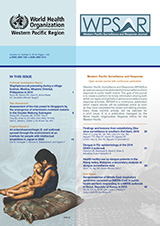Staphylococcal poisoning during a village festival, Medina, Misamis Oriental, Philippines in 2014
DOI:
https://doi.org/10.5365/wpsar.2017.8.2.005Abstract
Introduction: On 18 August 2014, cases of food poisoning in San Vicente Village were reported to the Event-Based Surveillance & Response Unit of the Philippine Department of Health. An investigation was conducted to identify the implicated source, describe the outbreak and evaluate the risk factors.
Methods: A case-control study was conducted. A suspected case was a previously well individual of Medina who attended the village festival and developed abdominal pain and vomiting with or without nausea, diarrhoea and fever from 18 to 19 August. A confirmed case was a suspected case with a rectal swab positive for bacterial culture. Rectal swabs, water and food samples were sent to the national reference laboratories. Food source and consumption interviews and environmental inspections were conducted.
Results: Sixty-four cases and 123 unmatched controls were identified. The median incubation period was 1 hour 15 minutes. Five cases (8%) were positive for Staphylococcus aureus, one (2%) for Aeromonas hydrophilia and one (2%) for Shigella boydii. One (14%) water sample was positive for Aeromonas spp. Of the collected food samples, beef steak was positive for Staphylococcus aureus. Risk factors were consumption of Filipino-style beef stew (odds ratio [OR]: 6.62; 95% confidence interval [CI]: 2.90–15.12) and stir-fried noodles (OR: 3.15; 95% CI: 1.52–6.50). Prolonged serving time and improper food storage were noted.
Discussion: In this foodborne outbreak, Staphylococcus aureus was the likely causative agent. Meals were contaminated due to improper food handling practices. We recommend that a policy be created to mandate that village-appointed food handlers undergo food safety training.

